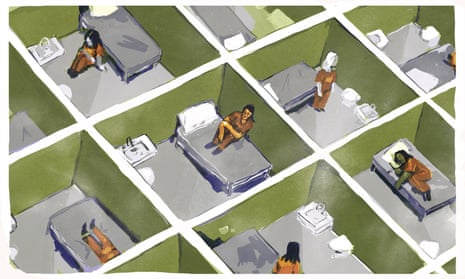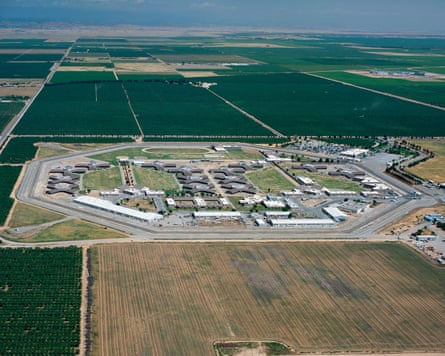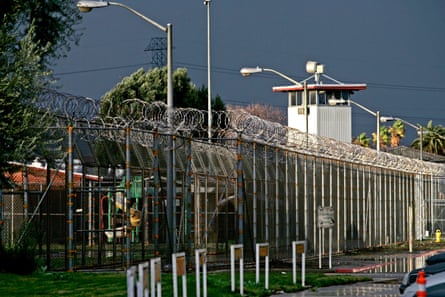A prison guard confessed to sexual misconduct. He got a year of paid time off and no charges

"Women incarcerated in California state prisons have filed hundreds of complaints of sexual abuse by staff since 2014. But in that time frame, only four officers have been terminated for sexual misconduct, according to data obtained by the Guardian. And only four guards have been confirmed to have faced criminal charges for their behavior.
One of the guards who was prosecuted, Gregory Rodriguez, has been accused of assaulting and harassing at least 22 women at the Central California Women’s Facility (CCWF). He retired while under investigation and is awaiting trial on nearly 100 charges. He has pleaded not guilty.
Of the others who were prosecuted, one case was dismissed, one guard pleaded no contest but had the conviction wiped from his record after the case was sealed, and a third pleaded no contest and was sentenced to two days in jail.
The low rate of prosecutions can be explained in part by the low number of cases found substantiated by the prisons and the department, which conduct the initial investigation into reports of abuse.
In rare instances where the institutions do acknowledge that abuse occurred, prison officials and prosecutors may decide that the behavior does not constitute a criminal violation.
And even when there is clear evidence of sexual assault, district attorneys, who regularly work with law enforcement and sometimes have ties to officers’ unions, may decline to file charges.
The California department of corrections and rehabilitation (CDCR) says it has moved to terminate 17 guards in its women’s prisons for sexual misconduct since 2014. Four of them were terminated, according to a spokesperson, Terri Hardy. Thirteen resigned or retired.
Survivors and their advocates say the system consistently fails victims. It feels as if “the investigative process doesn’t serve any purpose”, said Keiana Aldrich, who sued the state alleging sexual abuse by four prison staffers while she was incarcerated. When women do speak up, the system protects predators, she argued: “They just pass your case along, and it gets dismissed, and they don’t care … All officers stand together.”
‘I had proof’
Aldrich’s uphill battle is illustrative of the experiences of many women who come forward with reports of abuse inside CDCR.
Aldrich was making 35 cents an hour working as a janitor at the California Institution for Women (CIW), the other women’s prison, in June 2018 when her nightmare began, her civil complaint alleged. The wages were enough to help her buy hygiene products and food she otherwise couldn’t afford. But soon after starting the job, she said, her supervisor Ivan Ordaz repeatedly sexually assaulted her. After she complained to a lieutenant, Ordaz was transferred out of the unit where she was working, but another supervisor also started groping and grabbing her, she said.
The second supervisor, Samuel Navarro, gave her shirts and candy, and a “love letter” urging her not to tell, which she turned over to investigators, she said. Records show Navarro admitted to prison investigators he’d written the letter and “kissed” her, which would appear to constitute criminal misconduct – by law, an officer cannot have a consensual relationship with an incarcerated person, and any sexual contact is considered abuse.
But Navarro was neither fired nor prosecuted. The prison deemed Aldrich’s claim “unsubstantiated” and Navarro quietly resigned.
“I had proof and they still did nothing,” she said.
In June 2019, Aldrich was again sexually abused, this time by David Sanches, an officer who followed her into her cell and groped her, she alleged in a complaint. Records show Sanches later admitted to the prison’s investigators that he’d repeatedly looked at Aldrich naked from outside her cell and had written her sexually explicit letters. In a written confession to a lieutenant, he said: “The purpose of this memorandum is to tell on myself.”

But a month after he sent the letter, it was Aldrich who faced punishment: she was charged with “extortion by means of force or threat”, with an incident report listing the officer as the “victim”. The “extortion” claim, her lawyers said, was based on the fact that Aldrich’s roommate had written to the officer threatening to report his misconduct.
Aldrich was sentenced to solitary confinement and had her prison term extended by roughly 180 days.
Records show the prison ultimately concluded Sanches had engaged in sexual misconduct with Aldrich, lied about it and engaged in “insubordination”, “disobedience” and other violations. Sanches was on paid leave for a year after he wrote his confession. In August 2020, CDCR informed him he was being terminated, but allowed him to resign first.
CDCR referred Sanches’s case to the San Bernardino district attorney’s office for prosecution, but the DA declined to file charges. A spokesperson for the DA did not answer questions about the case, but said in an email that in general, “our office will turn down charges when there isn’t sufficient evidence to prove guilt beyond a reasonable doubt”.
It’s unclear if Aldrich’s “extortion” rules violation was ever dismissed; she was freedseveral months after Sanches’s resignation, after she was resentenced when the courts recognized her as a survivor of childhood sex trafficking who should not be imprisoned.
She ultimately won two settlements totaling $450,000 from the state.
CDCR declined to comment on the case. An attorney for Navarro declined to comment, referring questions to the corrections department. A lawyer for Sanches did not respond to inquiries. The state justice department represented Ordaz in the lawsuit and also declined to comment. In filings, the three men’s lawyers denied that they had sexually abused Aldrich.
Aldrich said the experience led her to repeatedly attempt suicide: “I couldn’t cope. I wanted to get out of there so badly, but you can’t just open the gates and leave.” She eventually found lawyers who helped, she said. “I could only cope once I had people on my side listening to my story.”
“I speak out now for my friends who are still in there. Because nothing is being said and nothing is being done, and I want people to really see what goes on,” she said.
A national crisis
Jenny Huang, one of Aldrich’s civil rights lawyers, said the only time she sees claims substantiated is when a victim becomes pregnant or guards admit misconduct. Bringing civil cases can be especially dangerous while women remain imprisoned, due to the threat of retaliation, she said. With Aldrich, she found success once she came home: “We sue the prisons over and over again and they keep settling these cases, but the problem seems to have only gotten worse.”
California recently settled seven women’s lawsuits against Rodriguez for $3.9m, according to their lawyer, Robert Chalfant.
Sexual assault in prisons occurs in states across the US and is a growing crisis as the number of women behind bars has soared.
The last federal survey of incarcerated people, conducted in 2011 and 2012, counted roughly 47,000 people who had been sexually abused by staff in the previous 12 months, about 2% of the incarcerated population. It’s the best data point for estimates of the prevalence of abuse, though government officials acknowledge it’s a significant undercount, because it’s a snapshot in time that does not account for the total number of people behind bars in a given year.
Out of those tens of thousands of victims, only a fraction file official complaints, with many women fearful of retaliation, including solitary confinement, discipline, loss of privileges and further violence by guards.

And only a fraction of reported complaints are substantiated by a prison investigation. The most recent national report on incidents that were disclosed by the institutions, which encompasses the years 2016, 2017 and 2018, said there were 2,496 confirmed victims of staff sexual abuse nationally.
The situation in California echoes the national picture. Data on the cases that do get reported in California, while limited, suggests few women end up filing claims. In a 2016 report based on interviews with more than 130 randomly selected CCWF residents, civil rights lawyers recorded more than 80 incidents of alleged sexual assault and abuse by guards. That year, the prison itself reported a total of 28 allegations of sexual misconduct, a figure that includes claims of abuse committed by other incarcerated people.
Rita, a 36-year-old recently released from CDCR, said she had been assaulted by Rodriguez roughly six years ago in an area with no cameras or witnesses, but had never disclosed it. She is not included in the criminal prosecution of the former officer: “I’d been a role model in prison. I never got in trouble, and I was really trying to change my life … and he told me, ‘Nobody is going to believe you.’ So I stayed quiet.”
The majority of reported cases are ultimately dismissed by the prisons. The federal Prison Rape Elimination Act (Prea) requires institutions to track claims of sexual misconduct, and Prea data shows that California’s men’s and women’s prisons, which house 95,000 people, received an average of more than 600 prisoner complaints of staff sexual misconduct and harassment per year from 2017 to 2022.
For the cases for which CDCR concluded its investigations in that time frame, it concluded 96% of them were “unsubstantiated” or “unfounded”.
At CCWF, the latest audit found that out of 24 claims of sexual abuse by guards between March 2021 and March 2022, six were deemed “substantiated”. Out of nine sexual harassment investigations, zero were substantiated.
The situation is similar at CIW; a 2021 Prea report revealed that out of 200 claims of sexual harassment and abuse by guards from 2015 through early 2021, 12 cases (6%) were substantiated; 108 (54%) were ruled “unfounded”, meaning CDCR concluded “no incident occurred”; 52 (24%) were “unsubstantiated”, meaning investigators couldn’t verify the claims; and 28 (14%) remained open.
The vast majority of cases are dismissed because women may lack physical proof to verify their claims, guards’ accounts are believed over victims, staff cover for each other, and CDCR’s investigators fail to interview witnesses, according to state audits and advocates’ accounts.
A recent audit of CDCR’s handling of staff misconduct by the state inspector general rated the department’s performance as “poor” in 56% of the cases it reviewed in 2022, finding that the prisons’ investigators and internal affairs staff failed to identify threats to people’s safety, did not properly classify allegations of misconduct, failed to gather and review evidence, mishandled the interview processes and submitted incomplete reports to wardens.
One particularly harrowing example of investigators’ neglect for victims came with a botched sting operation, in which CIW staff used two women as “bait” to catch a guard engaged in misconduct and failed to intervene when he assaulted them again. CDCR and its attorneys declined to comment on the case; in court filings in the matter, a CIW lieutenant admitted the officer assaulted the women during the sting, and that investigators monitoring the operation did not stop the attacks.
Sally Moreno, the Madera county district attorney, who is prosecuting Rodriguez, filed charges on behalf of 13 women, not his 22 potential victims CDCR disclosed. She said in an interview that not all of the claims were criminal violations that could be proved “beyond a reasonable doubt” in court.
But she said the broader lack of charges for sexual misconduct over the years stemmed in part from the way the institutions operate: “The prisons are intentionally opaque …They prefer to handle their own business rather than have anybody do any real oversight.”
Advocates say it’s clear sexual abuse is a systemic problem that requires systemic solutions.
Why women are so vulnerable
There is no good international data on sexual violence behind bars, but human rights advocates say it’s a global phenomenon in prison settings. UK data recently revealed nearly 1,000 prison rapes have been reported in England and Wales since 2010. Reports have suggested rampant abuse in Egypt and New Zealand. A 2022 US Senate report on federal women’s prisons found that staff have abused women in at least two-thirds of facilities, with some abused for months or years.
“Sexual violence is one element of a structural system that disregards women as individuals and deprives them of liberty and autonomy,” said Macarena Sáez, executive director of the women’s rights division of Human Rights Watch, a global non-profit.
Advocates have found that sexual assault by guards is linked directly to poor prison conditions and deprivation. When women are denied access to adequate food, menstrual products, physical space, soap, medical and mental health care, and communication with their families, they become significantly more vulnerable to abuse by guards, said Linda McFarlane, executive director of Just Detention International, a nonprofit that combats sexual violence in prisons and conducts trainings for officers. “These are things that people need to live with basic dignity and health, and so the power of those who do have access to those things increases exponentially.”

Officers have been found to exploit the fact that many incarcerated women are mothers, and some were primary caregivers before their imprisonment, coercing them into sexual abuse by threatening to reduce their contact with their children or promising to expand it.
Women may also be imprisoned in remote locations far from their families, McFarlane added.
Advocates have called on CDCR to implement policies to reduce those vulnerabilities. They have also demanded the system improve its reporting process to ensure timely and thorough investigations, , offer widespread access to trauma-informed counseling with outside clinicians, remove officers who are under investigation for abuse and expedite release of survivors.
CDCR officials declined repeated interview requests over several weeks.
Jeff Macomber, the head of CDCR, told lawmakers at an August hearing that the department was participating in a working group with advocates to improve whistleblower protections and trauma services for sexual abuse survivors. He said CDCR had rolled out body cameras in the women’s prisons as a “deterrent”, and that serious complaints were now being investigated by officials outside of the prison.
But Tess Borden, an attorney with the Prison Law Office, a civil rights firm that has sued CDCR, said that on a recent visit to CCWF, she had observed many officers with their body cameras off, and the prison still had no camera in the hearing room where many of Rodriguez’s alleged rapes occurred. She said her firm had also found evidence of institutions failing to refer serious sexual assault cases to outside investigators.
Hardy, the CDCR spokesperson, said in an email that body cameras were “expected to be on during interactions with incarcerated persons” and that employees found to violate this policy were “subject to disciplinary action”. She acknowledged there was no camera in the hearing room, but said there was one in the hallway outside. And she said prisons were now “required” to refer staff misconduct claims to CDCR’s “centralized screening team”, which operates outside of the institution and decides how to proceed.
“CDCR takes all allegations of sexual misconduct very seriously. The department investigates all allegations of sexual abuse, staff sexual misconduct, and sexual harassment pursuant to its zero-tolerance policy and as mandated by [Prea],” Hardy said. “CDCR’s Prea policy also provides guidelines for the prevention, detection, response, investigation, and tracking of allegations against incarcerated people.”
‘Come forward’
Anissa De La Cruz, CCWF’s warden since March, said at the hearing where Macomber testified that the prison now had a sergeant dedicated to Prea complaints and that when victims reported abuse, protocols called for separation from the alleged perpetrator, evidence preservation, and offer of services.
“When incarcerated women report incidents of sexual assault, we respond with urgency, empathy and comprehensive care,” she said, adding that the prison was trying to transition away from an “us v them” mentality between guards and prisoners, in line with Governor Gavin Newsom’s recently announced reforms to make the state’s prison system more “humane”. The governor’s office declined to comment.
Aldrich said she hoped the prosecution of Rodriguez would at least make some officers think twice about abusing women in their custody and encourage more victims to speak up: “Sue them. Come forward. Tell your story. Don’t let it go.”
But she was not optimistic about widespread change: “It’s about the power that these officers have. They get what they want, and I don’t think it’s ever going to stop.”
No comments:
Post a Comment